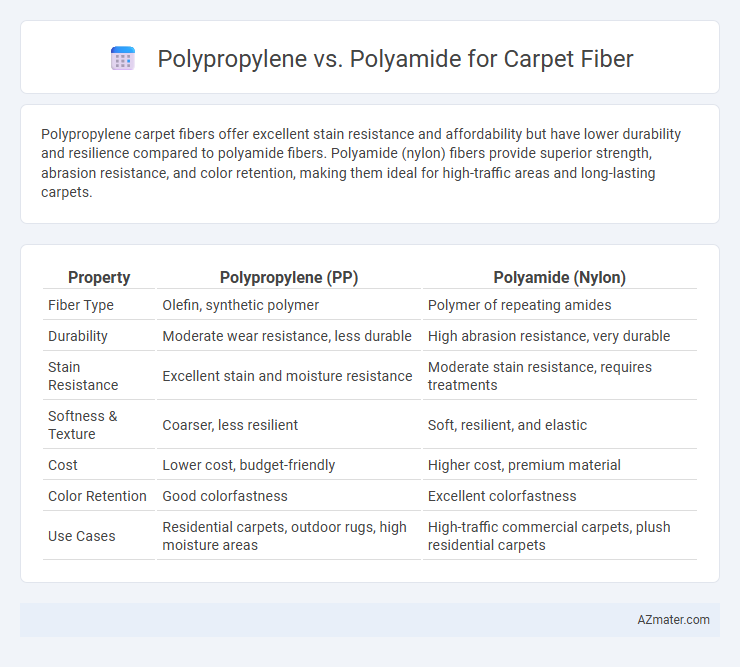Polypropylene carpet fibers offer excellent stain resistance and affordability but have lower durability and resilience compared to polyamide fibers. Polyamide (nylon) fibers provide superior strength, abrasion resistance, and color retention, making them ideal for high-traffic areas and long-lasting carpets.
Table of Comparison
| Property | Polypropylene (PP) | Polyamide (Nylon) |
|---|---|---|
| Fiber Type | Olefin, synthetic polymer | Polymer of repeating amides |
| Durability | Moderate wear resistance, less durable | High abrasion resistance, very durable |
| Stain Resistance | Excellent stain and moisture resistance | Moderate stain resistance, requires treatments |
| Softness & Texture | Coarser, less resilient | Soft, resilient, and elastic |
| Cost | Lower cost, budget-friendly | Higher cost, premium material |
| Color Retention | Good colorfastness | Excellent colorfastness |
| Use Cases | Residential carpets, outdoor rugs, high moisture areas | High-traffic commercial carpets, plush residential carpets |
Introduction to Carpet Fiber Materials
Polypropylene and polyamide are two widely used carpet fiber materials, each offering distinct advantages in durability and stain resistance. Polypropylene, also known as olefin, is valued for its moisture resistance, cost-effectiveness, and vibrant color retention, making it ideal for high-traffic areas and outdoor carpets. Polyamide, or nylon, is renowned for its exceptional strength, elasticity, and ability to withstand heavy foot traffic, providing superior resilience and long-lasting aesthetics in residential and commercial carpet applications.
What is Polypropylene Carpet Fiber?
Polypropylene carpet fiber is a synthetic thermoplastic polymer known for its durability, stain resistance, and affordability, making it a popular choice for residential and commercial carpeting. It is hydrophobic, which means it resists water absorption and dries quickly, contributing to its resistance to mold and mildew. Compared to polyamide (nylon), polypropylene offers lower moisture retention and excellent resistance to chemical exposure, but it tends to be less resilient under heavy foot traffic.
What is Polyamide (Nylon) Carpet Fiber?
Polyamide, commonly known as nylon, is a synthetic carpet fiber renowned for its exceptional durability, resilience, and resistance to wear and tear. It offers superior stain resistance and maintains its appearance over time, making it ideal for high-traffic areas in both residential and commercial settings. Polyamide carpet fibers provide excellent elasticity, allowing them to retain their shape and softness, outperforming polypropylene in terms of strength and longevity.
Durability Comparison: Polypropylene vs Polyamide
Polyamide fibers exhibit superior durability compared to polypropylene due to their higher resistance to abrasion, making them ideal for high-traffic carpet applications. Polypropylene, while cost-effective and resistant to stains and moisture, tends to wear out faster and can flatten under heavy foot traffic. The resilience and strength of polyamide contribute to a longer carpet lifespan, whereas polypropylene is better suited for low-traffic areas or budget-conscious installations.
Stain Resistance: Which Fiber Performs Better?
Polypropylene fibers exhibit superior stain resistance due to their hydrophobic nature, which repels water-based stains and prevents absorption, making them ideal for high-traffic areas prone to spills. Polyamide (nylon) fibers are more susceptible to staining because they absorb moisture and oily substances more readily, requiring more frequent cleaning and stain treatment. In terms of stain resistance, polypropylene outperforms polyamide, offering easier maintenance and longer-lasting appearance in carpets.
Comfort and Softness: Polypropylene vs Polyamide Carpets
Polyamide carpets offer superior comfort and softness compared to polypropylene due to their finer fiber diameter and higher resilience, providing a plush underfoot feel. Polypropylene fibers tend to be stiffer and less flexible, resulting in a firmer texture that may not be as comfortable for prolonged standing or sitting. The hydrophilic nature of polyamide also allows it to retain softness after cleaning, whereas polypropylene's hydrophobic properties can lead to stiffness over time.
Color Retention and Aesthetic Appeal
Polypropylene carpet fibers exhibit superior color retention due to their inherent resistance to UV light and staining, maintaining vibrant hues over extended periods. Polyamide fibers, while offering a softer texture and higher aesthetic appeal with a more luxurious and natural look, tend to fade faster under sunlight exposure and are more prone to discoloration. Balancing durability and visual appeal, polypropylene is preferred for bright, long-lasting carpets, whereas polyamide suits interiors prioritizing comfort with moderate colorfastness.
Cost Differences Between Polypropylene and Polyamide
Polypropylene carpet fibers are significantly more cost-effective than polyamide, typically priced 20-40% lower due to their simpler manufacturing process and lower raw material expenses. Polyamide, commonly known as nylon, incurs higher costs attributed to its superior durability and stain resistance, making it a premium choice despite the price difference. Budget-conscious buyers often prefer polypropylene for its affordability, while polyamide is favored in high-traffic or luxury carpet applications where longevity justifies the investment.
Environmental Impact and Sustainability
Polypropylene carpet fibers typically exhibit lower environmental impact due to their lower energy consumption during production and higher recyclability, being derived from thermoplastics. Polyamide fibers, while offering superior durability and resilience, generally involve higher energy use and greater carbon emissions during manufacturing, but advancements in recycling technologies are improving their sustainability profile. Considering biodegradability and chemical treatments, polypropylene often has an edge in eco-friendliness, although innovations in bio-based polyamides are closing sustainability gaps.
Choosing the Right Carpet Fiber for Your Needs
Polypropylene offers excellent stain resistance, moisture-wicking properties, and affordability, making it ideal for high-traffic areas and households with pets or children. Polyamide, known as nylon, provides superior durability, resilience, and abrasion resistance, suitable for heavy-use spaces requiring long-lasting performance. Choosing the right carpet fiber depends on balancing budget, foot traffic, and stain resistance needs to ensure optimal carpet longevity and appearance.

Infographic: Polypropylene vs Polyamide for Carpet Fiber
 azmater.com
azmater.com